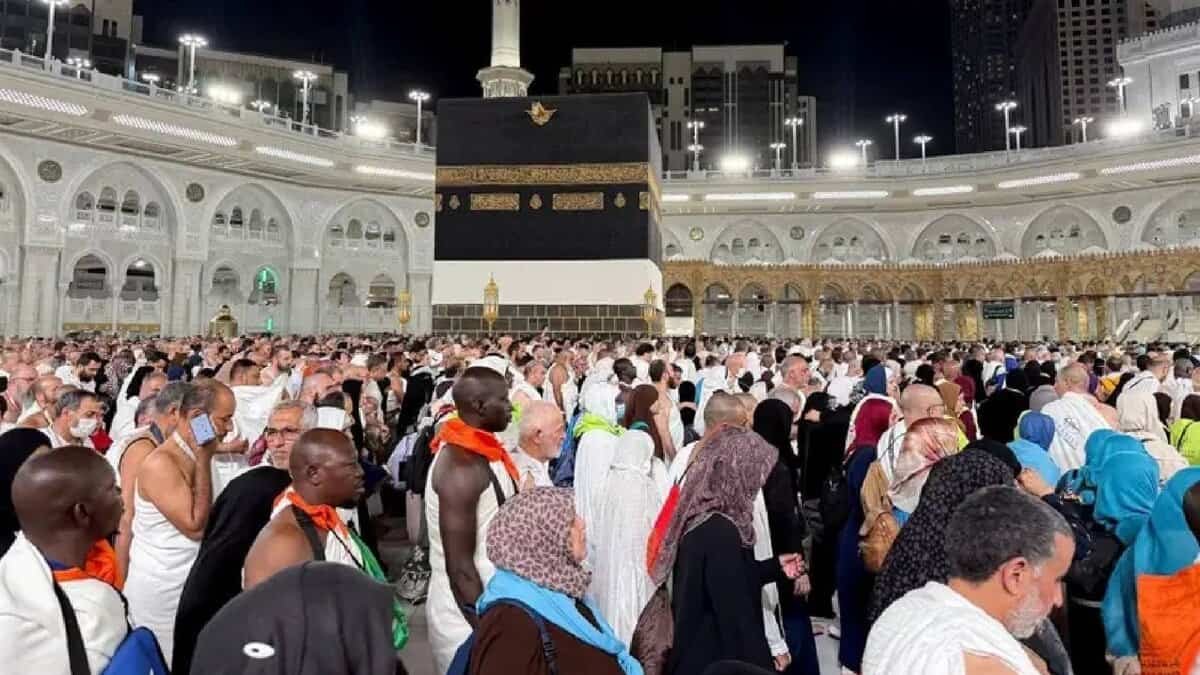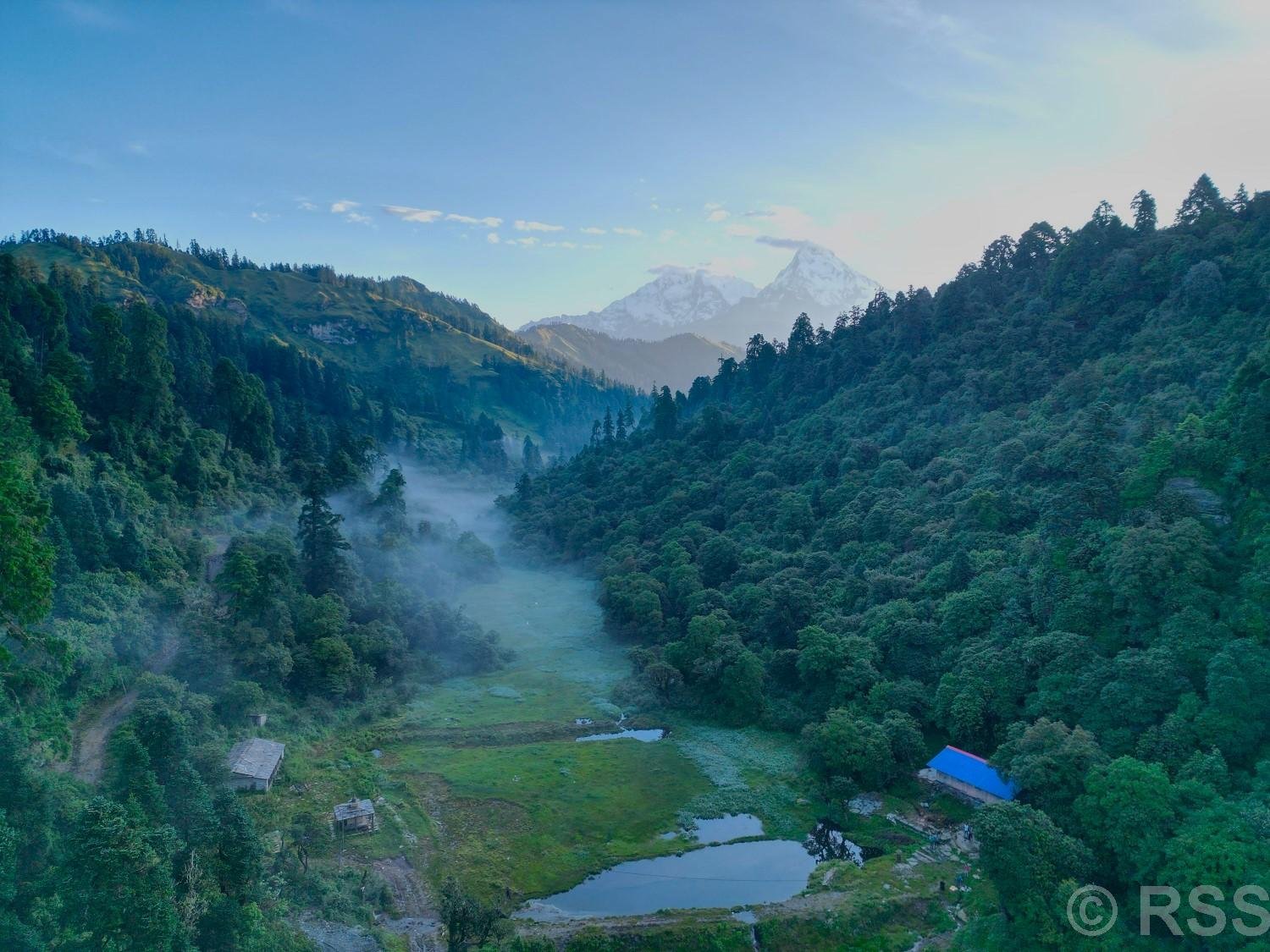Spiritual Travel
A spiritual journey amidst modern challenges

Every year millions of Muslims from all corners of the globe converge upon the holy city of Makkah in Saudi Arabia to perform Hajj. One of the five pillars of Islam, Haj is an obligation for all able-bodied and financially capable Muslims at least once in their lifetime. Hajj 2025 is scheduled to commence on June 4 and continue until June 9 corresponding to 8th to 13th days of Dhul Hijjah, the Islamic lunar calendar. Already 1.07 million pilgrims are in the Kingdom and the number is expected to grow, reaffirming its stature as one of the largest annual gatherings of people in the world. While for the pilgrims it marks the spiritual peak of their lives, for the Saudi Arabian government, it is an immense logistical challenge that tests the limits of planning, coordination, and infrastructure.
Spiritual significance of Haj
Haj is not merely a physical journey; it is a deeply spiritual experience that symbolizes submission to Allah. The pilgrimage is rooted in the life and trials of Prophet Abraham (Ibrahim in Arabic), his wife Hazrath Hajira (Hagar), and their son Prophet Ismail. Their unwavering faith and obedience to God’s commands form the foundation of the rituals observed during Haj.
The essence of Haj lies in reenacting acts performed by Abraham’s family. Pilgrims wear simple white garments called Ihram, symbolizing equality and humility before God. Over five days, they perform a series of rituals including:
- Tawaf: Circling the Ka’aba seven times.
- Sa’ee: Walking between the hillocks of Safa and Marwah in remembrance of Hajira’s desperate search for water for her son.
- Standing at Arafat: A day of supplication at Mount Arafat, commemorating the final sermon of Prophet Muhammad.
- Stoning of the Devil (Rami al-Jamarat): Symbolic rejection of evil, performed in Mina.
- Animal sacrifice: Marking the willingness of Prophet Abraham to sacrifice his son in obedience to Allah’s command.
For many, Haj is a transformative journey that brings about personal reflection, repentance, and spiritual rebirth. Pilgrims return with a renewed sense of purpose and a deeper connection to their faith.
A global convergence
Haj is unique in the way it brings together Muslims from diverse cultures, ethnicities, and languages. It is a profound expression of the unity of the Islamic Ummah (community) where socio-economic status, nationality, and personal identity dissolve into a collective act of worship. There is no royalty here, only loyalty to the Creator. All distinctions of colour, race and status fade away. This global gathering in one of the harshest environments poses considerable challenges — from maintaining hygiene and ensuring safety, to managing food and shelter, to facilitating transportation and medical care.
The logistic challenge
Hosting millions of people in a short span of time is a colossal task. Over the decades, the Saudi Arabian government has invested heavily in infrastructure and technology to manage the complexities of Haj. Cities like Makkah, Mina, Arafat, and Muzdalifah, which play key roles during the pilgrimage, have undergone significant transformations.
In recent years, incidents involving stampedes, overcrowding, and heat-related illnesses have prompted authorities to prioritize crowd control and safety. Modernization projects recently executed include:
- Expanded pedestrian routes and shaded walkways to shield pilgrims from the intense sun.
- Advanced transport systems, including dedicated Haj buses and a high-speed train network between Makkah and Madinah.
- Upgraded facilities in Muzdalifah, including rubber flooring and the planting of over 10,000 trees for natural shade.
- Technology integration such as electronic bracelets, GPS tracking, and multilingual mobile apps for directions, alerts, and health advisories.
The Saudi government has also developed contingency plans for emergencies, with thousands of security personnel, volunteers, and medical staff deployed to handle crises, offer assistance, and maintain order.
Health and safety, growing concerns
With rising temperatures in the region, protecting pilgrims from heat-related risks has become a top priority. For Haj 2025, the Saudi Ministry of Health has released a comprehensive health awareness kit in eight languages — Arabic, English, French, Urdu, Persian, Indonesian, Malay, and Turkish. This is a landmark step toward making essential health information accessible to the diverse pilgrim population.
The health kit advises pilgrims to:
- Avoid prolonged sun exposure.
- Use umbrellas or hats.
- Drink plenty of fluids.
- Follow hygiene practices to prevent infections.
Medical facilities have been strategically placed across pilgrimage sites, equipped to handle emergencies, heatstroke cases, and other ailments. Vaccinations and health screenings are made mandatory before pilgrims arrive, and awareness campaigns are conducted through media and religious institutions.
Haj in cooler seasons
The 2025 Haj will be the last to occur during the intense summer heat for the next 16 years.
According to the Saudi National Meteorological Center, starting in 2026, the annual pilgrimage will gradually move into cooler seasons – initially into spring and eventually into winter – thanks to the Islamic lunar calendar’s annual shift of about 10 days earlier each year. This transition is a welcome relief for pilgrims, offering more moderate weather conditions in the years to come.
A lifelong dream fulfilled
For the individual pilgrim, despite all the logistical and environmental hurdles, Haj remains an unforgettable spiritual journey. The sense of unity, humility, and submission that Haj instills often leads to lifelong changes in behavior, outlook, and faith. Many describe it as the most emotionally powerful experience of their lives – a moment when the soul feels closest to its Creator.
As pilgrims chant “Labbaik Allahumma Labbaik” (Here I am, O Allah, here I am), they echo a timeless declaration of faith, made in the footsteps of prophets. And while the world outside sees Haj as a logistical marvel, for the pilgrim it is a sacred convergence of devotion, sacrifice, and divine presence.
In a world fractured by division, the annual pilgrimage stands as a powerful reminder of faith’s ability to bring humanity together in peace and devotion
Spiritual Travel
Sobhita Dhulipala visits Velankanni Church and Nagore Dargah during spiritual trip to Tamil Nadu – Watch |

Actor Sobhita Dhulipala recently shared some pictures of her spiritual getaway in Tamil Nadu. The ‘Made in Heaven’ star took to Instagram on Thursday to share glimpses from her serene trip, which included visits to the iconic Velankanni Church and Nagore Dargah.
At Velankanni Church and Nagore Dargah
The actor shared photographs of her travels in her post with the title of “Life lately.” In these images, Sobhita was seen in a white outfit praying at the Velankanni Church, known formally as “The Basilica of Our Lady of Good Health”. The church is one of India’s most frequented Catholic shrines.Sobhita also visited the Nagore Dargah, a prominent Sufi shrine in Tamil Nadu located in the coastal town of Nagore. For this visit, she wore a black outfit, which complemented the modesty of the Dargah as well as fit with the overall spiritual tone of the site. The Dargah is the final resting place of the Sufi saint Nagore Syed Abdul Qadir Shahul Hamid.
Enjoying the beach
Sobhita also shared pictures of herself enjoying some peaceful moments at the beach as the waves washed over her feet. One photo shows her, with a calm expression on her face, relishing the sun and the joy of the moment. Another photo shows her feeling completely joyful alone. She also shared a photo looking beautiful in a gold saree from a friend’s wedding.On the work front, Sobhita was last seen in ‘Monkey Man’, Dev Patel’s directorial debut, which did not see a theatrical release in India. She also starred in ‘Love, Sitara’, but has remained quiet about her upcoming projects.Sobhita made headlines last year after she got married to Telugu star Nag Chaitanya after a long rumoured relationship.
Spiritual Travel
Jaljala holds potential for religious tourism but remains neglected « Khabarhub

Jaljala area in Myagdi/RSS
MYAGDI: Jaljala, located at the tri-junction of Myagdi, Parbat, and Kaski districts, holds significant religious and tourism potential but remains largely neglected due to lack of infrastructure and promotion.
The Jaljala area, spanning Modi Rural Municipality in Parbat and Annapurna Rural Municipality in Myagdi, is referred to in Hindu scriptures as Hampal, Kalanjar, and Mrigasthali. Despite its religious importance, the area suffers from underdevelopment and poor accessibility.
According to cultural and heritage expert Prof. Dr. Jagannath Regmi, Hindu scriptures including Agni, Garuda, Kurma, Baraha, Skanda, Shivamaha, Padma, Brihannaradiya, Linga, Matsya Puranas, the Mahabharata, and the Shrimad Bhagavatam mention Hampal and Kalanjar.
“Despite being praised in sacred texts, Kalanjar—highlighted by Muktakantha in mythological literature—remains underdeveloped due to lack of publicity, remoteness, limited road access, and the absence of documented materials beyond oral traditions and natural and cultural sources,” said Regmi.
He noted that some ancient temples, shelters, and caves in the area are now at risk of disappearing due to a lack of protection. Religious texts claim that sages once performed penance in the Jaljala region, using its herbs for medicine, gaining spiritual insights, and offering Pinda (ancestral offerings) to attain salvation.
Tika Pun of Lespar, Modi Rural Municipality-4, who operates a small restaurant in Jaljala, said that due to limited awareness of the site’s religious and scenic value, tourist and pilgrim numbers remain low.
“Visitors mainly arrive during Mahayagyas held in autumn and spring. Otherwise, the place remains deserted,” he added.
Situated at an altitude of 3,300 meters, Jaljala features a gorge surrounded by breathtaking views of the Annapurna range. Just two decades ago, locals from Jaljala and Modi Rural Municipality used to graze cattle here during the monsoon, a practice that has since vanished.
From Jaljala, a 10-minute walk to Wi-Fi Hill offers views of Annapurna, while a 30-minute hike to Mateko Lake reveals panoramic views of Dhaulagiri, Annapurna, and Machhapuchhre.
According to Govinda Sharma, a visitor from Kushma, the scenic beauty of the region and surrounding settlements makes the challenging journey worthwhile.
Jaljala is also rich in biodiversity. Medicinal herbs such as bojo, satuwa, chiraito, amilo, brahmi (bholatapre), pashanbhed, jethimadhu, padamchalnu, niramasi, jatamasi, timmur, and siltimmur are found here. Wildlife sightings include deer along the banks and birds like vultures, cuckoos, and owls.
The region is accessible by trekking routes from Ghodepani, Pun Hill, Mohare Danda, Nagi (in Myagdi), and Modi Rural Municipality in Parbat. A dirt road connects Jaljala to Lekphant and Shalija in Jaljala Rural Municipality, according to Vice-Chairman Deepak Acharya.
“A grand yagya was organized to highlight Jaljala’s religious significance, and electricity has now been extended to the area,” Acharya said. “The federal government has allocated Rs 30 million for tourism infrastructure development here.” The Beni–Lekphant road has also been blacktopped recently, and further road upgrades have been requested.
Spiritual Travel
Thomas Cook India & SOTC Travel deepen focus on spiritual tourism

Thomas Cook (India) Limited, the omnichannel travel services company, and its Group Company, SOTC Travel, have announced the expansion of their spiritual portfolio across key pilgrimage destinations in India and the subcontinent, catering to both group and customized tours.
Traditionally, Indian spiritual pilgrimages have often been perceived as challenging and uncomfortable —marked by long journeys, limited connectivity and infrastructure. Recognising these challenges, Thomas Cook India & SOTC Travel have designed tours by introducing aerial darshans, guided tours, VIP access for darshans and more.
Rooted in the philosophy that ‘India is a Pilgrimage’, the tours have been designed to cater to the spiritual aspirations of a broad spectrum of travellers – from GenS (seniors) who value time-honoured traditions, multi-generational families to millennials and GenZ travellers seeking spirituality as a path to mindfulness, wellness and cultural discovery—seamlessly blending sacred journeys with unique local experiences.
Key highlights:
- A curated portfolio of 11 iconic pilgrimage sites across India’s vast geography, covering temples, shrines and sacred rivers across India and the Indian subcontinent
- Certified local tour experts who offer deep insights into the history and cultural significance of each site, while facilitating seamless access and VIP/escorted darshans at key pilgrimage locations
- Special aartis, pujas and spiritual rituals conducted with accompanying pandits for a personalized spiritual experience
- Pure Vegetarian/Jain meal options to align with travellers’ religious and dietary preferences
- Premium aerial darshans (via helicopters) at select pilgrimage sites for faster, more comfortable access to remote & high-altitude spiritual circuits
Top group tour pilgrimage circuits
- Char Dham Yatra (Yamunotri, Gangotri, Kedarnath, Badrinath) — The Himalayan spiritual circuit of great reverence via aerial darshans
- Kailash Mansarovar Yatra — A sacred journey to the abode of Lord Shiva via aerial darshans
- Kashi Prayagraj Ayodhya Bodh Gaya Yatra — Sacred sites along the river Ganga, steeped in mythology and history, rites and rituals.
- Dwarka Somnath Yatra — Gujarat’s twin pilgrimages celebrating Lord Krishna and Lord Shiva
- Tirupati to Trivandrum — South India’s iconic temple circuits for spiritual fulfilment
- Haridwar Rishikesh Yatra — Spiritual wellness on the banks of the Ganges
- Ujjain Omkareshwar to Bhimashankar Grishneshwar Yatra — sacred Shiva circuits in Malwa region of Madhya Pradesh to Maharashtra
- Kashi to Kathmandu To Muktinath To Janakpur – Bharat Nepāl Mahayātrā covering spiritual landmarks across both nations
- Puri Jagannath Yatra – a cornerstone of India’s Char Dham circuit and key spiritual landmark in Odisha
- Ramayan Yatras Covering India, Sri Lanka and Nepal
- Short Getaways to Vaishno Devi, Amritsar, Shirdi, Rishikesh, Mathura, Velankanni, etc.
In addition, we also offer a wide range of customised pilgrimage tours tailored to individual preferences and requirements.
Rajeev Kale, President & Country Head, Holidays, MICE, Visa – Thomas Cook (India) Limited said, “Spiritual tourism is no longer limited to a season or festival – it has become a year-round experience.
“India’s vast spiritual landscape offers travellers an unparalleled opportunity to engage with its deep-rooted spiritual ethos, while also immersing themselves in the country’s rich heritage and culture.
“With an intent is to inspire not just seniors and families but also young India’s millennials, working professionals and groups of friends, we have expanded our spiritual tours at key spiritual sites coupled with unique local experiences like river-rafting and kayaking in Rishikesh, paragliding in Vaishno Devi, cuisine trails in Varanasi and Haridwar.
“This initiative strengthens our domestic and spiritual travel segment, offering travellers a meaningful way to connect with the soul of India,” Kale added.
S.D. Nandakumar, President & Country Head – Holidays and Corporate Tours, SOTC Travel Limited said, “We are witnessing strong demand for our Darshans portfolio, with destinations like Char Dham and Kailash Mansarovar ranking among the most sought-after pilgrimage sites.
“There is also significant interest in Ayodhya, Dwarka, Vaishno Devi, Tirupati, Rishikesh, Haridwar, and Ujjain. This is gaining momentum not just from India’s metro cities, but also from regional mini-metros and tier 2–3 cities.
“To enhance comfort and convenience, we have introduced premium aerial darshans to select sacred locations via helicopters.
“Furthermore, address the challenges of spiritual travel in India, we’ve curated end-to-end tours that offer our customers assurance and ease—covering transport, accommodation, VIP/escorted darshans, guides and more.
“Our meaningful TravSure assurance programme covers select pilgrimage sites ensuring a safe, smooth and hassle-free experience with comprehensive travel insurance and on-ground support,” Nandakumar added.
-

 Brand Stories3 weeks ago
Brand Stories3 weeks agoBloom Hotels: A Modern Vision of Hospitality Redefining Travel
-

 Brand Stories2 weeks ago
Brand Stories2 weeks agoCheQin.ai sets a new standard for hotel booking with its AI capabilities: empowering travellers to bargain, choose the best, and book with clarity.
-

 Destinations & Things To Do3 weeks ago
Destinations & Things To Do3 weeks agoUntouched Destinations: Stunning Hidden Gems You Must Visit
-

 Destinations & Things To Do2 weeks ago
Destinations & Things To Do2 weeks agoThis Hidden Beach in India Glows at Night-But Only in One Secret Season
-

 AI in Travel3 weeks ago
AI in Travel3 weeks agoAI Travel Revolution: Must-Have Guide to the Best Experience
-

 Brand Stories1 month ago
Brand Stories1 month agoVoice AI Startup ElevenLabs Plans to Add Hubs Around the World
-

 Brand Stories4 weeks ago
Brand Stories4 weeks agoHow Elon Musk’s rogue Grok chatbot became a cautionary AI tale
-

 Brand Stories2 weeks ago
Brand Stories2 weeks agoContactless Hospitality: Why Remote Management Technology Is Key to Seamless Guest Experiences
-

 Asia Travel Pulse1 month ago
Asia Travel Pulse1 month agoLooking For Adventure In Asia? Here Are 7 Epic Destinations You Need To Experience At Least Once – Zee News
-

 AI in Travel1 month ago
AI in Travel1 month ago‘Will AI take my job?’ A trip to a Beijing fortune-telling bar to see what lies ahead | China












